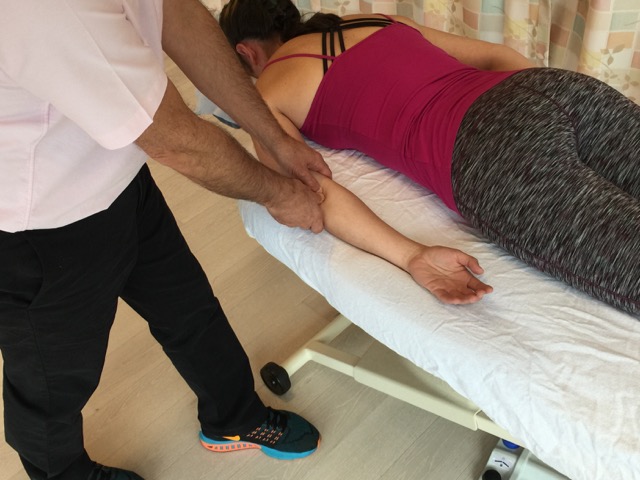Manual therapy treatment for golfer’s elbow:
Golfer’s elbow is primarily caused by overuse and tension of the muscles of the common flexor tendon, therefore manual therapy treatment should be directed to this musculature. As with tennis elbow, a good protocol for manual (massage) therapy involves fascial spreading, longitudinal and cross fiber strokes, and pin and stretch technique. Because the muscles of golfer’s elbow cross the wrist, joint mobilization of the carpal bones may also be beneficial.
Begin with fascial spreading strokes to the entire forearm with concentration on the proximal anterior forearm. Longitudinal strokes to the anterior forearm are performed proximally to distally, with your pressure decreasing as the muscles transition from bellies to tendons. Cross fiber work should be focused on the common flexor tendon near the medial epicondyle. If the condition has entered the degenerative phase, extremely strong deep friction cross fiber pressure, including the use of tools (e.g., Graston Technique), is often recommended. The intent of deep pressure is to create inflammation and draw fibroblasts to the region to facilitate the healing process of the degenerated collagen fibers. Pin and stretch is performed by holding sustained pressure on the musculature as the patient’s/client’s hand and fingers are actively or passively extended. Pin and stretch technique is often employed by moving the pin (sustained compression) point of each successive repetition farther distally down the anterior forearm.
If inflammation is present, icing is also an important part of the treatment protocol. Icing can be done before soft tissue manipulation to decrease sensitivity and allow for deeper work. It can also be done after soft tissue manipulation to minimize possible swelling as a result of the soft tissue work.
Once direct care to the anterior forearm/wrist/hand region has been done, it is wise to work the entire upper quadrant on that side. Begin at the neck, and work your way down into the upper back, shoulder region, arm, posterior forearm, and hand. Although these regions are not directly responsible for golfer’s elbow, they may be involved in dysfunctional postural and movement patterns that may contribute to golfer’s elbow.
Summary of Manual Therapy Treatment Protocol for Golfer’s Elbow
| 1. Fascial spreading strokes to the anterior forearm |
| 2. Longitudinal strokes to the anterior forearm |
| 3. Cross fiber work to the common flexor tendon |
| 4. Pin and stretch to the anterior forearm |
| 5. Ice the common flexor belly/tendon |
| 6. Joint mobilization of the carpals |
| 7. Work entire upper quadrant on that side |
Precautions/contraindications:
When working on a client/patient who has golfer’s elbow, be aware that very deep pressure may translate to the ulnar or median nerves. The ulnar nerve passes into the forearm on the anteromedial side, deep to the musculature of the common flexor tendon. The median nerve is located between the two heads of the pronator teres in the midline of the anterior forearm.
Click here for an article on how to treat tennis elbow with manual therapy.
Note: This is the fourth of five blog post articles on golfer’s elbow.
The five articles are:
- What are the causes of Golfer’s Elbow?
- What are the signs and symptoms of Golfer’s Elbow?
- How do we assess (diagnose) Golfer’s Elbow?
- How do we treat Golfer’s Elbow with manual therapy?
- What are the self-care and medical approaches to Golfer’s Elbow?



